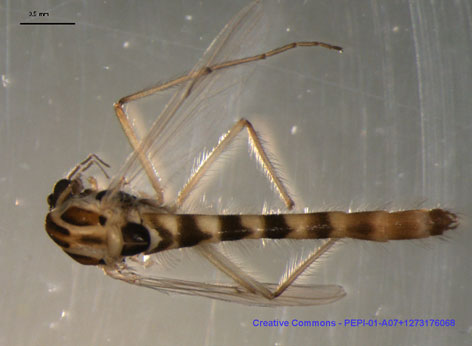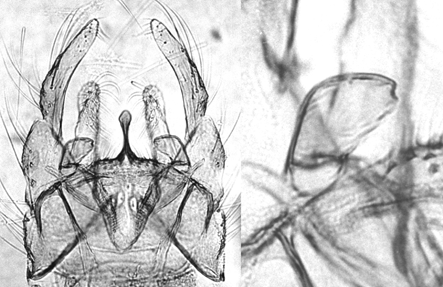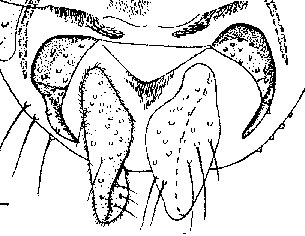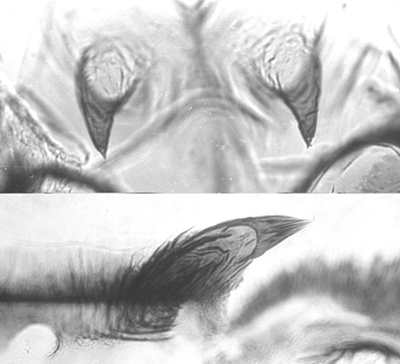Species y. C. riparius Meigen, 1804 Syn: C. thummi thummi Meigen - Credland (1973a)
C. serus Malloch, 1915
C. cristatus Branch 1923
C. militaris Johannsen 1938In Bold Bin: BOLD:AAA7263Adult:

Male: Wing length about 3.7-3.8 mm. AR about 3.2-3.6. LR about 1.6-2.95.
Ground color pale to dark brown, thoracic markings red-brown to blackish brown;
legs pale green to light brown towards their bases, tarsal segments darker;
abdomen brown to blackish, apical 0.25 of each tergite pruinose and pale.
Specimens from colder habitats are darker.
Head: Frontal tubercles small10-30 x 15 µm (l/w 1.5-2), clypeus rather small (0.66-0.72 of diameter of antennal pedicel) with 34-39 setae. Palpal proportions (micron) 69 : 69 : q29 : 130 : 191 (P5/P4 - 1.47).
Some thoracic setae: Dorsocentral - 27-33; Prealar – 6-7; Supraalar - 1-2; Scutellar - about 24 setae; 9 in 2 rough anterior rows and 15 larger setae in posterior row.
Leg lengths (micron) and proportions (1 specimen):
| Fe
| Ti
| Ta1
| Ta2
| Ta3
| Ta4
| Ta5
| LR
| F/T
| BR
| PI
| 1530
| 1465
| 2005
| 1745
| 825
| 760
| 345
| 2.95
| 1.04
| 2.05-2.95
| PII
| 1595
| 1595
| 925
| 530
| 385
| 260
| 185
| 0.58
| 1.0
|
| PIII
| 1870
| 1975
| 1330
| 810
| 610
| 365
| 220
| 0.67
| 0.95
|
| M SensCh 13-14; H SensCh 12-14
Male hypopygium and superior volsella of C. ripariusAbout 3-10 setae in separate pale spots, on tergiteIX. The superior volsella is Strenzke's S(b) type. Inferior volsella long, reaching to about middle of gonostyle, with simple setae. Gonostyle only moderately swollen and narrows gently from about midpoint or more rapidly over posterior 2/3. Anal point narrow at base and widening at distal end. Female: According to Townes (1945), similar to male except for usual sexual differences.
About 13 setae on crescent shaped segment X, which is about 3.3 times longer than the greatest width.. Morisch & Wülker (1987) Fig. 1 shows the cercus to have a relatively pointed posterior end, with a significant ventral bulge.  Pupa: (partly from Palearctic material of Langton & Visser, 2003)
Length of exuvia 8.1-10.0 mm long; inner margin of wingcase 2.02-2.05mm.
Color brown to dark brown.
Cephalic tubercles conical, narrower in males than in females, 95x85-137x107 µm (Nearctic sizes about the mean of this range, male 106x67 µm); frontal setae 33-37 µm. Lacking frontal warts.
Basal ring 133-180x63-89 µm (Nearctic specimens near largest measures); HR 1.91-2.33.
Hook row entire, length row 0.51-0.65 of segment width, 87 (67-97) hooks.
Armament of tergites II-VI in the form of an undivided patch of strong points, the points in each segment increasing in size posteriorly. The point patches increase in size from from TII-V, but on TVI the patch is more or less reduced. Armament of TII-VI not strongly waisted and with posterior transverse patch not successively increasing in extent to TVI, usually reduced on VI. 
Pupal cephalic tubercles and caudolateral spur of segment VIII of C. ripariusSpur of segment VIII with 1-5 (mostly 3-4) closely appressed spines.
Anal lobes weakly rounded; 130 (97-164) (mean 149 in N.A.) taeniae in up to four rows. Larva a medium sized thummi-type, length 10.5-16.5 mm (female 14.78 (12.6-16.5) mm; male 12.1 (10.5-14.4) mm). Gular region dark, frontoclypeus and other parts of the head capsule darkened. Ventral tubules variable in length but anterior pair longer than the poserior pair, anterior about 1.42 (0.46-2.21) µm; posterior 1.53 (0.92-2.21) µm. Lateral tubules lacking.
Mentum (Fig. c) with pointed teeth; fourth laterals in line with the third and fifth laterals (type I); centre tooth moderately broad with almost parallel sides, c2 well seperated, notches almost vertical (type III).
Ventromentum (Fig. d) with about 43 striae. Pecten epipharyngis (Fig. a) with about 13-14 sometimes irregular teeth (essentially Ty. A). Premandible (Fig. a) with relatively broad teeth, inner tooth about 3-5 times the width of the outer tooth, coming to a relatively broad point (type B2).
Mandible (Fig. e) with third inner tooth pale and only partially separated (type II). Cytology: 4 polytene chromosomes with the thummi arm combination AB, CD, EF, G. Centromere regions distinctly heterochromatic.
Arm G normally paired with a subterminal nucleolus and generally with 2 Balbiani rings near the centre, the second followed by a constriction and a dark band. No nucleoli in long arms.
Sequences described in Europe as C. thummi (=riparius). MD located about 2a on arm F (Hägele 1985, Kraemer & Schmidt 1993), although it could be closer to the centromere at about F11-15, the site found in some individuals of the Australian C. oppositus (Martin 2010).
No chromosomal polymorphism reported in North America.
ripA1: 1 - 19
ripB1: 1 - 28
ripC1: 1 - 22
ripD1: 1 - 24
ripE1: 1 - 13
ripF1: 1 - 23Found: Manitoba - Southern Indian Lake (Rosenberg et al., 1984).
Northwest Territories - Smoking Hills (Jernelov et al. 1981)
Ontario - Amherstview, (Lake Ontario?) (44.22°N, -78.65°W); Etobicoke Creek nr. Brampton (43.68°N, 79.75°W) (Shrivastava & Loughton 1970);
Stratford; Windsor; ; 2.5 ml. s & w Clarence Creek (45.50°N, -75.22°W), Russell Co.
Kansas - Douglas Co. (Townes 1945); Mill creek, nr. Craig, Johnson Co.
Maryland - Baltimore, Baltimore Co.
Missouri - Columbia, Boone Co.
New York - Adams Center, Jefferson Co. (Branch 1923); Ithaca, Tomkins Co.
South Carolina - Liberty, Pickens Co.
South Dakota - 1 m W, 2 ml. N Yankton, and 3 ml. W Yankton, Yankton Co.
Tennessee - Oak Ridge (abt 36.00°N, -84.16°W), Anderson Co.
Wisconsin - Badfish Creek, Dane Co.; Trout Lake Limnological Station (46.03°N, -89.67°W), Vilas Co.
Wyoming - Hawk Springs, Goshen Co.
Greenland (but see Species 5c (1TE) and Sp.5l)
Type locality - "Europe" Creeks and pools, particularly where polluted and especially if polluted by milk waste. Adult re-described by Townes (1945).
Larvae described by Johannsen (1938) as C. militaris, and biology and all life history stages (including photographs) as C. cristatus by Branch (1923). Cytology given by a number of authors in North America (e.g. Poulson and Metz 1938, Blaylock 1971) and in Europe as C. thummi Kieffer (e.g. Keyl and Keyl 1959, Devai et al. 1989).Credland (1973b) established a method for maintaining this species in the laboratory. See also C. sp. f, C. sp. 2c, C. sp. 2e, C. sp. 5c(1TE), and C. sp. 5l.[ Return to Index| Go to References ] |



